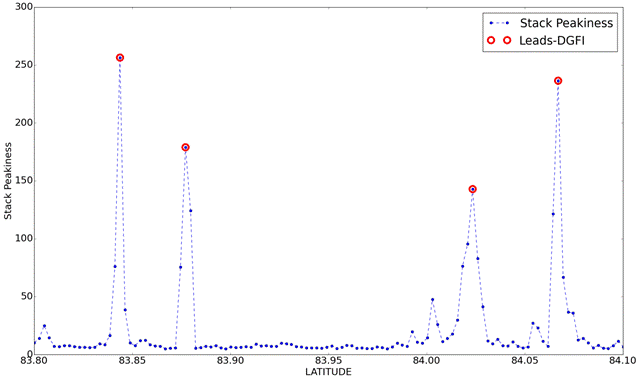Abstract's details
Exploiting Cryosat-2 stack data for nadir-lead detection in sea-ice regions
Event: 2016 SAR Altimetry Workshop
Session: Applications, SAR for science
Presentation type: Oral
In the Arctic and Antarctic Ocean, part of the sea surface is seasonally or continuously covered by sea ice. In these areas, it is important to isolate the altimeter echoes that are reflected back by leads, long and narrow fractures in the ice. Lead echoes, coming from specular surfaces, have a very high backscatter coefficient that can dominate the altimeter return even if the lead is hundreds of meters away from the nadir position (off-nadir leads). The sea level computed from off-nadir leads reflections is therefore affected by biases and errors.
The recognition of leads is based on the classification of altimeter waveforms. The new SAR altimetry missions, in which the averaged waveform is formed by summing up several looks acquired at different look angles and stacked together, can be exploited to reduce the "false-lead detections", i.e. the lead-like waveforms that correspond to off-nadir leads and are erroneously used for sea level estimation.
In this study, we analyse the Stack Product of Cryosat-2, available from the ESA GPOD service. We propose the adoption of a new parameter, the Stack Peakiness" (SP) and we show its behaviour along tracks orbiting above sea ice regions compared to the other Stack parameters that are currently available in the official product (Stack Kurtosis and Stack Standard Deviation). The SP compares the main return (expected to come from the nadir echo) w.r.t. the rest of the stack: when crossing a lead, SP grows, peaks and decreases, revealing the most likely location in which the lead is seen at nadir. The Stack Peakiness is then used as a parameter to classify the echoes into leads and ice and the results are quantitatively validated against SAR images from Sentinel-1. We propose the adoption of the Stack Peakiness parameter in the standard products of the SAR altimetry missions and we emphasize the importance of making the Stack Product of SAR altimetry freely available to expert users.

The recognition of leads is based on the classification of altimeter waveforms. The new SAR altimetry missions, in which the averaged waveform is formed by summing up several looks acquired at different look angles and stacked together, can be exploited to reduce the "false-lead detections", i.e. the lead-like waveforms that correspond to off-nadir leads and are erroneously used for sea level estimation.
In this study, we analyse the Stack Product of Cryosat-2, available from the ESA GPOD service. We propose the adoption of a new parameter, the Stack Peakiness" (SP) and we show its behaviour along tracks orbiting above sea ice regions compared to the other Stack parameters that are currently available in the official product (Stack Kurtosis and Stack Standard Deviation). The SP compares the main return (expected to come from the nadir echo) w.r.t. the rest of the stack: when crossing a lead, SP grows, peaks and decreases, revealing the most likely location in which the lead is seen at nadir. The Stack Peakiness is then used as a parameter to classify the echoes into leads and ice and the results are quantitatively validated against SAR images from Sentinel-1. We propose the adoption of the Stack Peakiness parameter in the standard products of the SAR altimetry missions and we emphasize the importance of making the Stack Product of SAR altimetry freely available to expert users.

Contribution: APPS_01_SARworkshop2016_Passaro_DD_16h00.pdf (pdf, 2851 ko)
Back to the list of abstract